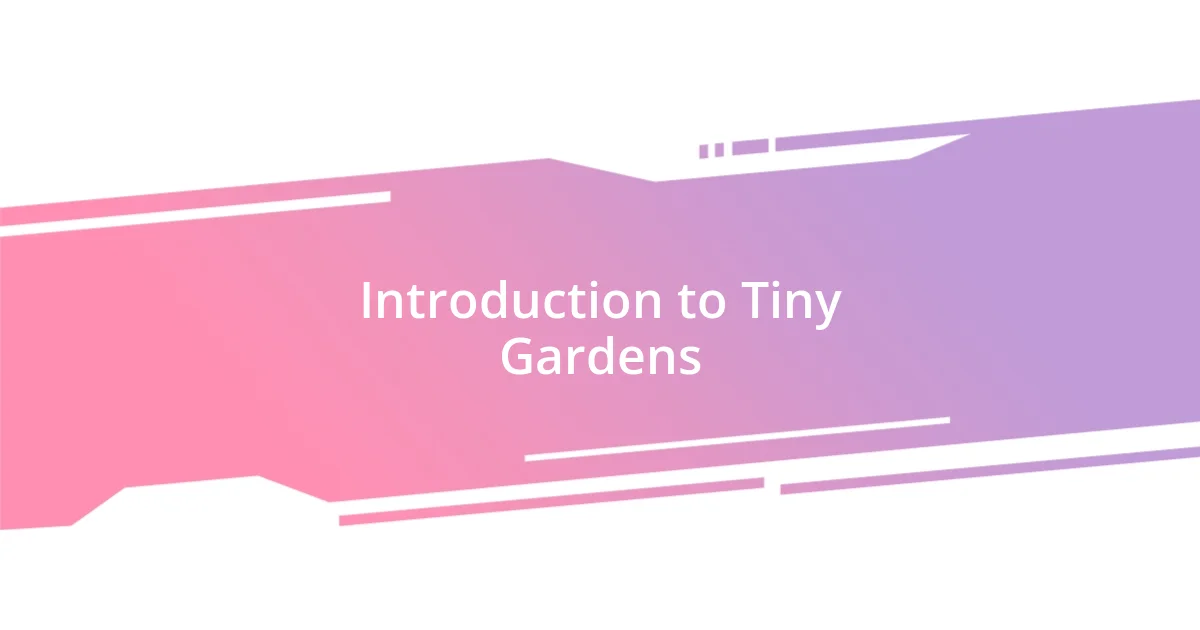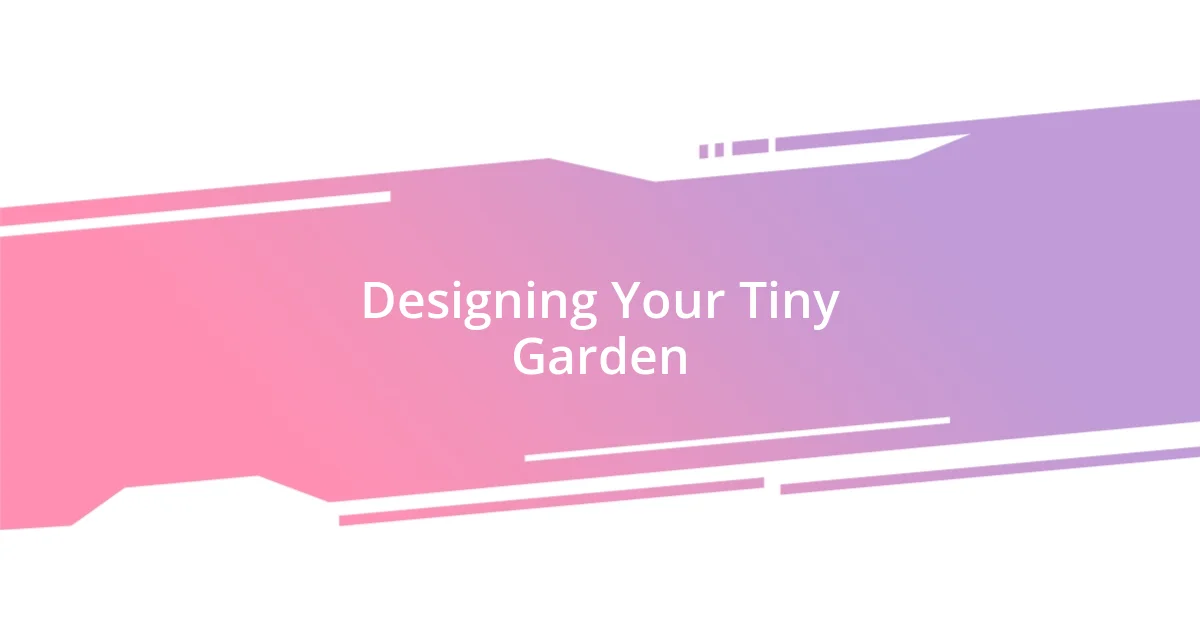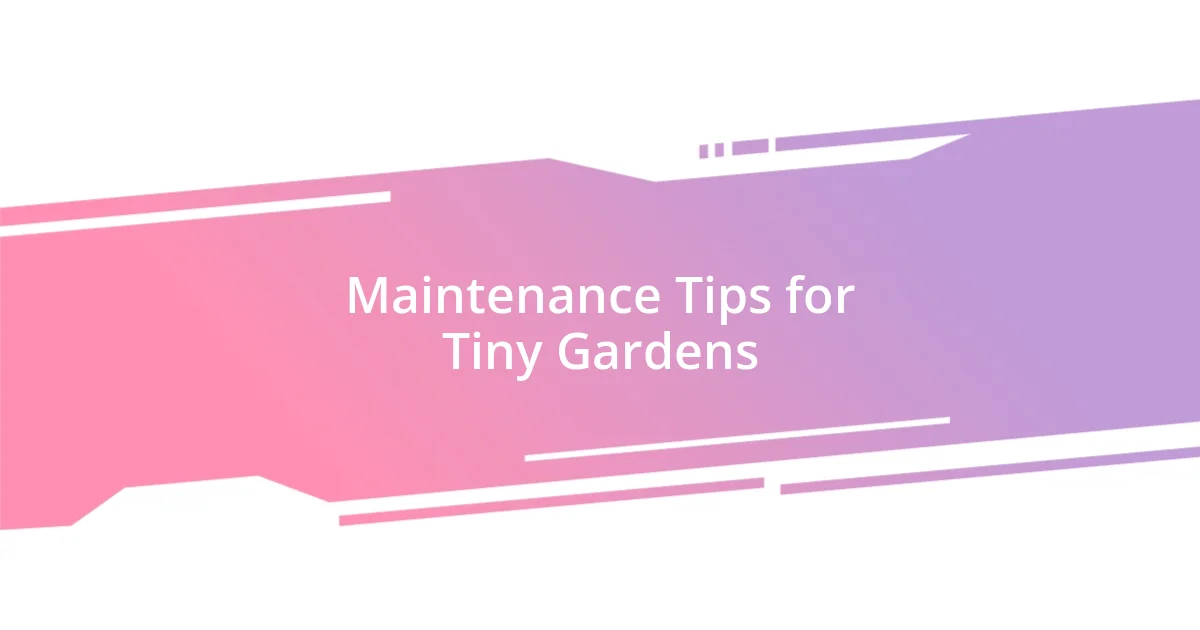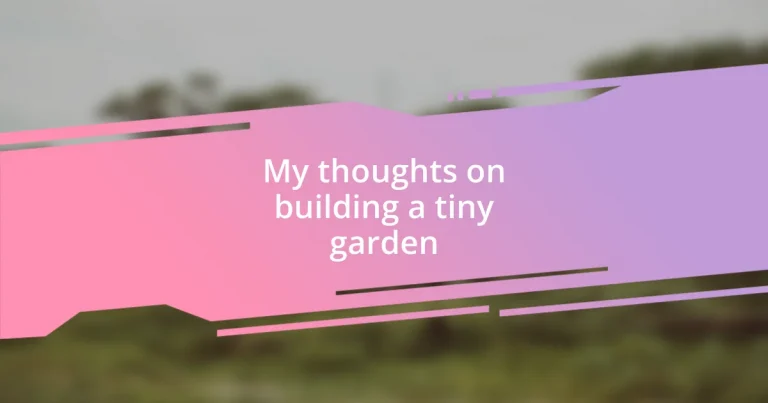Key takeaways:
- Tiny gardens enhance limited spaces, fostering personal connections and joy through nurturing plants.
- Choosing the right location and suitable plants is essential for growth and maintenance in small gardens.
- Design and regular maintenance routines, including seasonal plant rotation, keep tiny gardens vibrant and enjoyable.

Introduction to Tiny Gardens
Tiny gardens are a delightful way to experience the joys of gardening, even in limited spaces. I still vividly remember the first time I created my own mini oasis on a small balcony; it felt like I was crafting my own little world among the concrete. Have you ever considered how a few pots filled with vibrant flowers can completely transform your living space?
The beauty of tiny gardens lies in their versatility. They can be as simple as a collection of potted herbs on a windowsill or as intricate as a vertical garden on a city wall. I took a day to mix and match different containers and plants, and witnessing the lively combination of colors and scents unfold was truly rewarding. Isn’t it amazing how much life you can bring into a small area with just a little creativity?
What makes tiny gardens even more compelling is the personal connection they foster. Each plant, whether it’s a hearty succulent or a delicate fern, tells a story of care and growth. I often find myself talking to my plants as they flourish, and it’s a comforting reminder that nurturing something, no matter how small, can enrich our daily lives. Aren’t we all looking for those little moments of joy in our busy routines?

Choosing the Right Location
Choosing the right location for your tiny garden is essential, as it can significantly affect your plants’ growth. I remember the moment I decided on a sunny corner of my balcony, and watching my herbs thrive there was immensely satisfying. A space that receives at least six hours of sunlight a day is ideal for most plants; however, some might prefer partial shade. Have you thought about how sunlight direction impacts your choice?
Additionally, it’s crucial to consider accessibility. I learned this the hard way when I planted my seedlings in a spot that became a chore to reach. Keeping your garden in an easily accessible location not only encourages regular care but also heightens your daily enjoyment of it. Imagine the difference it could make to just step outside and pluck fresh herbs for dinner without a second thought!
Here’s a quick comparison of factors to consider when choosing a location, which I found very handy in my own gardening journey:
| Factor | Ideal Location |
|---|---|
| Sunlight | At least 6 hours of direct sunlight |
| Accessibility | Easily reachable for daily care |
| Protection from Wind | Shielded from strong winds or harsh weather |
| Drainage | Area that drains well to prevent waterlogging |

Selecting Suitable Plants
Selecting plants for your tiny garden is a thoughtful process that can greatly enhance the overall look and feel of your space. I recall my excitement when I chose my first set of plants, which included cheerful marigolds and lovely trailing ivy. It was a joyful moment, filled with anticipation as I pictured how they’d transform my small area into a vibrant sanctuary. When selecting plants, consider not just aesthetics but also growth habits and needs, as this will make future care much easier.
To help you in deciding which plants are best suited for your garden, I’ve found it useful to think about the following points:
- Light Requirements: Does the plant need full sun, partial shade, or full shade?
- Growth Habit: Opt for compact varieties that won’t outgrow space quickly.
- Water Needs: Choose drought-tolerant plants if you want a low-maintenance option.
- Local Climate: Pick plants that thrive in your regional climate for better resilience.
- Personal Preference: Select plants that resonate with you emotionally, whether they remind you of a childhood garden or a favorite memory.
Every journey with plants becomes a story, and each selection adds a chapter to your tiny garden narrative.

Designing Your Tiny Garden
Designing your tiny garden often starts with envisioning how you want the space to look and feel. I vividly remember sketching out my garden plan, cutting out pictures of blooming flowers and lush foliage from magazines. It felt like playing with a vision board, and I realized how important it was to create a space that reflected my personality. Have you ever considered how colors and shapes can evoke different emotions in a garden setting?
Choosing the right layout is key to maximizing the small area. For instance, I experimented with vertical gardening when I was short on floor space. By using trellises and wall planters, I not only saved room but also added an element of vertical interest that made my garden feel more expansive. This approach can invite a sense of depth; doesn’t it just make the space more dynamic?
Don’t forget about the hardscape elements, like pathways and borders, which can define your garden’s structure. I found that using stepping stones not only guided my guests but also created a lovely visual flow through my little oasis. As you’re designing yours, think about how each element interacts. How do you want to guide the eye through your space?

Maintenance Tips for Tiny Gardens
Maintaining a tiny garden can feel overwhelming at first, but I’ve learned that the key is to develop a routine that suits your lifestyle. My watering schedule is a good example; I often water my plants early in the morning, which not only ensures they get the moisture they need but also helps me start my day with a bit of tranquility. Have you tried setting a specific day for upkeep? This consistency can help prevent those pesky chores from piling up.
In my experience, keeping a close eye on your plants is crucial. I remember a time when I neglected my herbs for just a week, and they became leggy and sad. Now, I make it a habit to inspect my plants regularly, checking for pests or signs of distress. How often do you take the time to appreciate your garden? A few minutes of observation can save you from bigger problems down the road.
Another insightful tip is to embrace the changing seasons. I’ve discovered that rotating plants every few months helps keep the garden fresh and reduces the risk of disease. This summer, I swapped out a few annuals for winter-hardy varieties, and the transformation was refreshing. What about you? Trying new plants can rekindle your excitement and keep your tiny garden vibrant!














